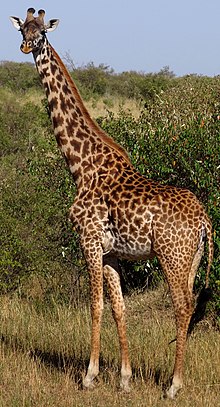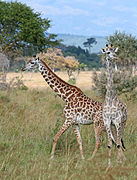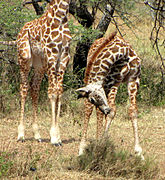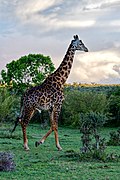Masai giraffe
| Masai giraffe | |
|---|---|

| |
| An adult female masai giraffe in the Masaai Mara national park, Kenya. | |
| Scientific classification | |
| Domain: | Eukaryota |
| Kingdom: | Animalia |
| Phylum: | Chordata |
| Class: | Mammalia |
| Order: | Artiodactyla |
| Family: | Giraffidae |
| Genus: | Giraffa |
| Species: | G. tippelskirchi
|
| Binomial name | |
| Giraffa tippelskirchi (Matschie, 1898)
| |

| |
| Range in dark pink | |
| Synonyms | |
|
Giraffa camelopardalis tippelskirchi | |
The Masai giraffe (Giraffa tippelskirchi[2] or Giraffa camelopardalis tippelskirchi), also spelled Maasai giraffe, and sometimes called the Kilimanjaro giraffe, is a species or subspecies of giraffe. It is native to East Africa. The Masai giraffe can be found in central and southern Kenya and in Tanzania. It has distinctive jagged, irregular leaf-like blotches that extend from the hooves to its head. The Masai giraffe is currently the national animal of Tanzania.[3]
Taxonomy
The IUCN currently recognizes only one species of giraffe with nine subspecies
Description
The Masai giraffe is distinguished by jagged and irregular spots on its body. Its geographic range includes various parts of eastern Africa.[7][8][9] It is the largest-bodied giraffe species, making it the tallest land animal on Earth.[7] Bulls are generally larger and heavier than cows, weighing close to 1,300 kilograms (2,900 pounds) and growing up to 5.5 meters (18 feet) in height. In the wild, individuals can live to be around 30 years of age, and in most cases can live longer in captivity.[10] The Masai giraffe's most famous feature, its neck, contains seven vertebrae and makes up roughly one third of its body height. Its long and muscular tongue, which can be up to 50 centimeters (20 inches) in length, is prehensile and allows it to grab leaves from tall trees that are inaccessible to other animals. The tongue's darker pigment is believed to function as a natural sunscreen and prevent sunburn. On top of the head are two bony structures called ossicones which are covered by thick skin and have dark hair on the tips. These can be used during fights to club its opponent. Bulls usually have an extra ossicone present between the eyes.[11] When galloping, the Masai giraffe has been recorded to reach speeds of almost 64 kilometers per hour (40 miles per hour).[3]
Conservation
Masai giraffes are considered endangered by the IUCN,[1] and the Masai giraffe population declined 52% in recent decades due to poaching and habitat loss. The population amounts to 32,550 in the wild. Demographic studies of wild giraffes living inside and outside protected areas suggest low adult survival outside protected areas due to poaching and low calf survival inside protected areas due to predation; these are the primary influences on population growth rates.[12][13] Survival of giraffe calves is influenced by the season of birth[14] and the seasonal local presence or absence of long-distance migratory herds of wildebeest and zebra.[15] Metapopulation analysis indicated protected areas were important for keeping giraffes in the larger landscape.[16]
In situ conservation of Masai giraffes is being done by several government agencies, including the
Over 100 Masai giraffe live under human care in AZA accredited zoos in the United States.[19] At several zoos, Masai giraffe cows have become pregnant and successfully given birth.[20]
Masai giraffes can suffer from giraffe skin disease, which is a disorder of unknown etiology that causes lesion on the forelimbs. This disorder is being further investigated to better understand mortality in this species.[21]
Gallery
-
Masai giraffe in Serengeti National Park, Tanzania
-
Detail of head, taken at Cincinnati Zoo and Botanical Garden
-
Two Masai giraffes in Mikumi National Park
-
Two week-old Masai giraffes in Serengeti, Tanzania
-
Close up of giraffe face inMasai Mara
-
Maasai giraffe in the plain of Maasai Mara
-
Male Maasai giraffe
See also
References
- ^ . Retrieved 14 July 2019.
- ISBN 9781421400938.
- ^ )
- .
- PMID 28222287.
- PMID 32053589.
- ^ a b Dagg, A.I.; Foster, J. B. (1982). The Giraffe. Its Biology, Behavior, and Ecology (with updated supplementary material). Malabar, Florida: Krieger Publishing Company.
- PMID 18154651.
- PMID 27618261.
- ^ "How long do giraffe live? - Giraffe Conservation Foundation". 2019-03-14. Retrieved 2022-05-02.
- OCLC 587198932.
- ISSN 0022-2372.
- ISBN 9780124095489.
- S2CID 7611046.
- PMID 28031792.
- S2CID 24276021.
- PMID 29867255.
- S2CID 91251633.
- S2CID 51893147.
- ^ Gregory, Kim Lamb (May 10, 2014). "Mothers' nature in the animal world" Archived 2014-05-17 at the Wayback Machine Ventura County Star
- S2CID 10736316– via Science citation index.
External links
 Media related to Masai giraffe at Wikimedia Commons
Media related to Masai giraffe at Wikimedia Commons Data related to Giraffa camelopardalis tippelskirchi at Wikispecies
Data related to Giraffa camelopardalis tippelskirchi at Wikispecies








